|
|
Post by glactus on Oct 9, 2008 5:51:55 GMT
 The remarkable Horsehead Nebula is a dark globule of dust and non-luminous gas, obscuring the light coming from behind, especially the moderately bright nebula IC 434.  The Horsehead in IC 434 It is the most remarkable feature of an interesting region of diffuse nebulae, which belongs to a huge cloud of gas and dust situated 1,600 light years away in the direction of the constellation of Orion. The red glow originates from hydrogen gas predominantly behind the nebula, ionized by the nearby bright star Sigma Orionis. The darkness of the Horsehead is caused mostly by thick dust, although the lower part of the Horsehead's neck casts a shadow to the left. Streams of gas leaving the nebula are funneled by a strong magnetic field. Bright spots in the Horsehead Nebula's base are young stars just in the process of forming. Tremendously photogenic, The horsehead nebula is a true gem of the sky and can be seen with amateur telescopes. E E barnard recognized the object in the 1910s. The first published description of the Horsehead nebula was given by Barnard in 1913 and it was first cataloged by him in 1919.  Orion nebula Credits: These are NASA / Hubble and ESO images |
|
|
|
Post by Andy Mac on Oct 9, 2008 13:37:04 GMT
Indeed a lovely object - at least photographically.
I think the point needs to be made that this DSO is notoriously difficult to see visually from all but the darkest of skies. Using a Hbeta narrowband filter also helps. Also many people report the indentation known as the Horsehead (or B33 to give its official name) to be much smaller than had been imagined.
|
|